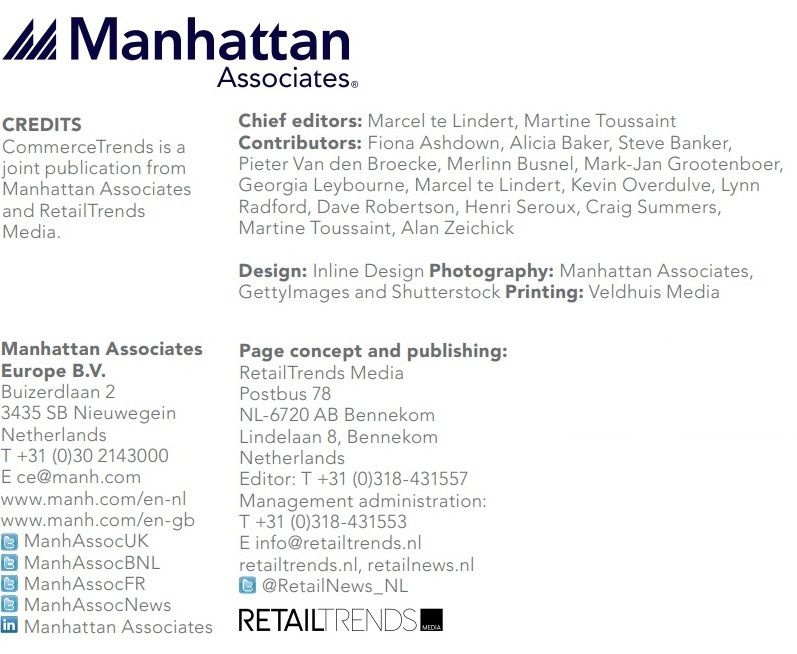The role of wholesalers is changing. Whereas they used to be the link between manufacturers and retailers/contractors, wholesalers are now increasingly becoming service providers. They need to adapt if they are to keep pace with the changing face of wholesaling, and digitalization can help them to do so – in the shape of an advanced warehouse management system (WMS) and order management system (OMS), for instance.
Pieter Van den Broecke from Manhattan Associates is an expert on the changing role of wholesalers. “Traditionally, wholesalers served an important function in the value chain. They formed the physical link between the manufacturers and the companies selling to end users. That automatically made them a key communication channel for manufacturers too, but that role has now been taken over by the internet. Physical contact is no longer necessary in order to do business.” For example, more and more manufacturers are in direct contact with end users through their own online stores. “Moreover, online marketplaces such as Amazon mean that end users can obtain products more quickly and conveniently. Nowadays, Amazon is used not only by consumers, but also by companies that need specific professional supplies. There’s a clear trend towards everyone in the value chain wanting to get as close to the end user as possible, and the traditional role of the wholesaler does not support that.”
Against that backdrop, it seems that wholesalers are in for a very rough ride. Van den Broecke is not quite so pessimistic, as long as wholesalers start to take action fast. “If they want to secure a role for themselves, they will need to be able to offer the same service, speed and reliability as Amazon – that’s a must. Besides that, wholesalers have to ensure they stay relevant by differentiating themselves not only from their competitors, but also from the manufacturers themselves. In contrast to manufacturers, wholesalers have the benefit of physical stores, and they can set themselves apart from Amazon by providing an on-site service centre. As a result, we’re seeing growth in service centres.”

Speed
Additionally, something needs to change in the relationship between the wholesalers and their customers. That relationship has traditionally been a transactional one, but Van den Broecke explains that it must now become based on emotion: “Even business customers are consumers when they are at home on the couch. They buy goods online, read reviews and appreciate good service. They want the same things in their business lives.” Wholesalers that stubbornly continue to take the traditional approach will not survive, he says. “Because others around them will change. Getting as close as possible to the end user means being proactive. Business customers expect the same experience that they receive as consumers, so ‘fast delivery’ doesn’t mean in three days’ time, but tomorrow – and preferably even today.”
Agility
Executing to those delivery windows calls for outstanding logistics to get orders to the right destination quickly. “You must be able to deliver on that promise, such as by opening small distribution centres and service points where customers can collect their orders. Ensuring that goods are in the right place at the right time is a complex process,” continues Van den Broecke. “To implement the necessary technological change, a company certainly needs a technology-minded board of directors because you can only achieve all this with an advanced warehouse management system (WMS) and order management system (OMS). After all, in addition to your current software you need an extra layer that can cope with customers’ new demands.” Van den Broecke has noticed that a large number of wholesalers are already on the right track: “It’s easier for the smaller operations who are more agile, and that’s much more of a challenge for bigger wholesale companies. Organisational agility is key.”
This interview with Pieter Van den Broecke appeared previously in evofenedex magazine.


The success of your wholesale business depends on your ability to exceed customer expectations: are you winning at each decision point?
What does your customer need?
Harry, a carpenter, needs material to build a fence for his customer. Harry needs reliable and accurate product information and delivery times from his supplier to keep his promise to the customer.
How will your customer engage with you? Online? Over the phone? In your depot?
Harry knows what he needs — now he has to find a way to buy it. When he searches online for the best price means every supplier is just a click away, while the demand for fast delivery puts the speediest fulfillers into pole position.
Will your customer buy from the fastest or the cheapest supplier?
Travelling between jobs, Harry happens to pass one of your depot branches and stops to see if the fence is in stock. Does your service point rep have the tools and information to secure the purchase?
What’s the best method of delivery?
Harry pays, and while he’s there, he also orders a number of other items.He selects these to be delivered directly to his address.
How do you maintain your profit margin?
Harry’s material needs to be in store for pick up by midday tomorrow. To do this, your fulfilment network has a number of options. It can drop-ship the item directly from the supplier, source the item from one of your regional distribution centres or send the item from a local depot.
How do you fulfil every order efficiently?
Harry’s fence arrives in your depot at 11:00 a.m. the next day. He collects the material, knowing he can deliver on his promise and finish the job with a happy customer.
Can you deal with exchanges and returns as efficiently as possible?
Harry needs to return one of his purchased items. A flexible returns process is a benefit to both your customers and you.
More information for wholesalers: manh.com/en-nl/wholesale









Reacties 0